20386_Science_with_STEM_Year_4_Earth_and_Space_Sciences_Surface_changes
You also want an ePaper? Increase the reach of your titles
YUMPU automatically turns print PDFs into web optimized ePapers that Google loves.
<strong>Earth</strong> <strong>and</strong> space sciences<br />
SURFACE CHANGES<br />
<strong>STEM</strong> project<br />
<strong>STEM</strong> project:<br />
Teacher notes<br />
Students create a l<strong>and</strong>form scene <strong>and</strong> film a video showing how the l<strong>and</strong>forms weather away <strong>and</strong><br />
erode <strong>with</strong> water.<br />
Estimated duration: 3–4 weeks<br />
1. Introduce the project<br />
• Play the video at to engage students <strong>and</strong> imagine<br />
they are junior geologists.<br />
• Display page 108 <strong>and</strong> read through,<br />
clarifying anything that students don’t<br />
underst<strong>and</strong>.<br />
2. Investigate<br />
• Students revise what weathering <strong>and</strong><br />
erosion are <strong>and</strong> how they work to change<br />
l<strong>and</strong>forms.<br />
• Students view a video at or scan the QR code on<br />
page 109, showing erosion in action in a<br />
time-lapse video. This will give them the<br />
idea of how their gelatine/s<strong>and</strong> molds will<br />
look when warm water is poured on them to<br />
dissolve away <strong>and</strong> ‘weather’ <strong>and</strong> ‘erode’.<br />
• Allow students time to explore iMovie ®<br />
or another video recorder, to familiarise<br />
themselves <strong>with</strong> how it works <strong>and</strong> to<br />
underst<strong>and</strong> how to add voice overs, sound<br />
effects, music or insert a file like a data table.<br />
3. Design, plan <strong>and</strong> manage<br />
• Students draw a plan of their scene <strong>and</strong><br />
the four l<strong>and</strong>forms they will include. They 5. Evaluate <strong>and</strong> refine<br />
should also consider what molds or shapes<br />
they will need to create their l<strong>and</strong>forms.<br />
• Students plan out what they will say during<br />
their video to describe the effects of<br />
weathering <strong>and</strong> erosion.<br />
• Students consider <strong>and</strong> write a list of what<br />
materials they will use to create their scene.<br />
Ensure students use an appropriate tray or<br />
clear container that can hold the water that<br />
is poured onto the gelatine/s<strong>and</strong> l<strong>and</strong>forms.<br />
4. Create<br />
• Ensure students have access to required<br />
materials. These could include a large<br />
plastic container or large aluminium tray,<br />
gelatine, s<strong>and</strong> or soil, bowls, a whisk,<br />
measuring cups, various molds or differentshaped<br />
containers or materials to make<br />
molds <strong>with</strong>, <strong>and</strong> access to warm water.<br />
• Once students create their molds or select<br />
the molds they want to use to represent<br />
their four l<strong>and</strong>forms, students create<br />
the gelatine/s<strong>and</strong> mixture, pour it into<br />
the molds <strong>and</strong> leave in the fridge to set<br />
overnight.<br />
• Once set, students flip the molds <strong>and</strong> create<br />
their l<strong>and</strong>scape scene, adding any other<br />
features to their l<strong>and</strong>scape such as trees.<br />
• Ensure students measure their various<br />
l<strong>and</strong>forms <strong>and</strong> compile the data in a table<br />
using Excel ® , PowerPoint ® or a similar<br />
computer program.<br />
• Students pour warm water over their<br />
l<strong>and</strong>forms, to act as rain, <strong>and</strong> film what<br />
happens. They may want to create a pouring<br />
instrument such as a polystyrene cup <strong>with</strong><br />
several holes in the bottom to act as rain.<br />
©R.I.C. Publications<br />
Low Resolution Images<br />
Display Copy<br />
• Students may wish to change their<br />
l<strong>and</strong>forms or add more features to their<br />
scene before pouring the water.<br />
• Students may also find that the pouring may<br />
not work well so can amend how they pour<br />
the warm water <strong>and</strong> re-shoot the video.<br />
6. Communicate<br />
• Once students have created their final<br />
video, they add their voice over explaining<br />
how weathering <strong>and</strong> erosion change<br />
l<strong>and</strong>forms over time. They also add sound<br />
effects or music, <strong>and</strong> insert the table of<br />
measurements once they have remeasured<br />
the ‘weathered’ <strong>and</strong> ‘eroded’ l<strong>and</strong>forms.<br />
R.I.C. Publications® – www.ricpublications.com.au YEAR <strong>Science</strong>:<br />
4 A <strong>STEM</strong> APPROACH 107


















